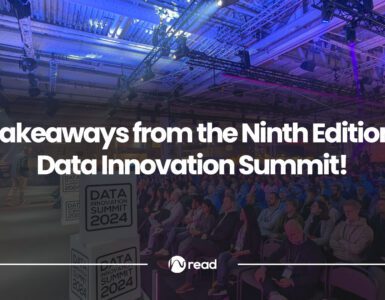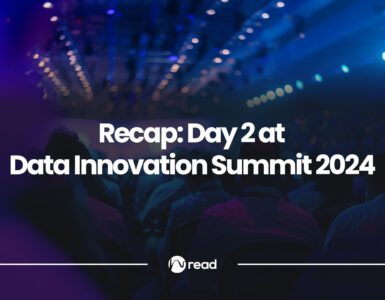In today’s digitalisation-powered and data-driven, speed-of-light changing world, customers have become more demanding than ever. And companies are looking for solutions to place customers in the centre of their business and know them like the back of their hand. This is where customer-centric data science finds its place – as a strategy for improving, personalising customer experiences with data science and considering business from a point of view of individual customers.
What is customer centricity exactly and why should data scientists care?
Ewan Nicolson, Principal Data Scientist at Skyscanner, quoted a nice definition at Data Innovation Summit 2019, that perfectly describes what customer-centricity is all about.
“Customer centricity is all about recognising that all of your customers are individuals, and changing your business approach so that you deal with customers as individuals, don’t consider them as one homogeneous group, Ewan quoting professor Peter Fader.
Ewan sees the customer-centric approach as a great approach for data science because it provides one of the best data sets to work with for data scientists. But not only that, customer-centricity gives data scientists a chance to solve problems in a novel way, explains Ewan. And last, but not least, data scientists are focused on solving real human problems by thinking about customers and the value delivered to them.


Working at Skyscanner – a travel, search and booking online platform with 80 million users per month, gives Ewan a lot of customer-centric data about searches, bookings, hotels, flights etc.
How to get customer-centric datasets
Talking from his experience, Ewan described the strategy and principles needed to get customer-centric datasets. Although his examples are about Skyscanner, they can be applied to any online company working with huge amounts of customer data.
To start with, every time a customer has an interaction with a product, it is logged as a row in the data set specifying the user ID, the time it was carried out as timestamp and the details of the interaction, for example, a search from Stockholm to London.
This is a simple dataset that provides several solid principles on how to get customer-centric datasets:
- Having strong understanding of what customer ID is – knowing who every individual customer is.
- Logging every single customer interaction in the dataset – which means the potential dataset is big and brings up the storage and accessibility question.
- Storage of a large volume of customer data in a secure way.
- Making sure there are no data silos – especially in the case with a third-party data provider
- Providing consent to use customer data
- Avoiding personal information – no demographic or personal information included, building purely behavioural dataset.


Why customer-centric data is perfect to work with
Recommendation and personalisation are big buzz words in data science, as Ewan states, but their realisation presents a challenge. But having created a customer-centric dataset, as shown above, we have a foundation to work on any sort of personalised recommendations.
Embeddings is a useful technique in this case Exan says, as it tells us that a customer that did a certain interaction, also did another interaction as well. E-commerce websites, such as the giant Amazon makes use of this technique a lot.


Customer-centric data science means that all our customers are different and we should think of them as distinct people.
How does it work? – Usually, the dataset is very sparse, meaning there are lots of users and items, and each user hasn’t interacted with many items so there is no overlap between them. With embeddings, instead of specifying every single user ID and item ID in the inventory, we define characteristics (50-100) that describe customers and items. Afterwards, a neural network is trained to predict whether a customer will like a certain item. The final result is not only a very good model that predicts but also a concise and clear description of all items and customer in a much smaller dataset.


Understanding customers’ long-term behaviour
Creating a customer-centric dataset and implementing embeddings is a very good start for giving personal recommendations. But it can also help us understand their long-term behaviour as individual customers.
As Ewan explains, long-term user understanding is a strong indication of whether the company will grow. However, understanding customer behaviour on the long-term is really difficult. What we can do to make it possible is break down this customer-centric dataset into different types of customers in terms of:
- Recency – How recently have customer interacted with the company.
- Frequency – How many times a customer has come back in a fixed period of time.
- Tenure – How long has a person been a customer for.
- Clumpiness – Using a service or product more frequently at a given period compared to other periods, for example, when a new series comes up on Netflix.
This way a customer-centric dataset provides a very powerful way of describing and understanding customers. It allows us to segment our customers and detect group formations with different behaviours, customer lifetime values and different preferences. Ewan explains that these dimensions complement nicely all other descriptions we have for our customers in the dataset, and they can be integrated into predictive models.


Customer lifetime value – CLV (churn)
Customer lifetime value is a vital problem to solve as it’s one of the main KPI’s for a company, states Ewan. The alternative term of CLV – churn is one of the most important things to worry about as it represents people that have stopped being your customers.
For a company with a non-contractual setting such as Skyscanner, it’s even harder to observe when customers are churning, because they just silently disappear, says Ewan.
But the customer-centric approach allows them to turn things around. For every customer, they have two random variables – one for the possibility of a customer churning (which can’t be predicted), and one for whether the customer has interacted with them in a time period (which can be predicted). They feed the parameters in a model which provide plots based on which they can predict which customers have the possibility of churning so they can give out special offers to encourage them to stay.
This technique is helpful for Skyscanner to break away from seeing their customers as one homogeneous group and start thinking of them as individual people. And here lies the real value of the customer-centric approach – not in the fancy modelling, but in seeing customers as different people with different characteristics, emphasises Ewan.
How customer-centric data science helps
The main key points from Ewan’s presentation as to the benefits of using the customer-centric approach in data science are:
- The customer-centric approach helps in creating a rich dataset
- It solves a problem in an innovative way. CLV is no longer an accountancy problem, but it’s a prediction of an individual user and how they are different from other users.
- It provides a much richer description of our customer, which can be implemented into the business to make better decisions.
- It doesn’t solve an academic, regression or classification problem. It deals with real people that are on the other end of the model. The approach contributes to adding customer value as the end product.
















Add comment